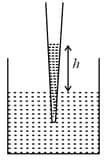EASY
Earn 100
The area of a liquid film is and surface tension is, . What is the work done to change area up to ?
(a)
(b)
(c)
(d)
50% studentsanswered this correctly
Important Questions on Viscosity and Surface Tension
MEDIUM
EASY
EASY
MEDIUM
EASY
EASY
HARD
MEDIUM
EASY
HARD
MEDIUM
HARD
MEDIUM
EASY
EASY
EASY
MEDIUM
EASY

MEDIUM
HARD
If two glass plates have water between them and are separated by very small distance (see figure), it is very difficult to pull them apart. It is because the water in between forms cylindrical surface on the side that gives rise to lower pressure in the water in comparison to atmosphere. If the radius of the cylindrical surface is R and surface tension of water is T then the pressure in water between the plates is lower by:


